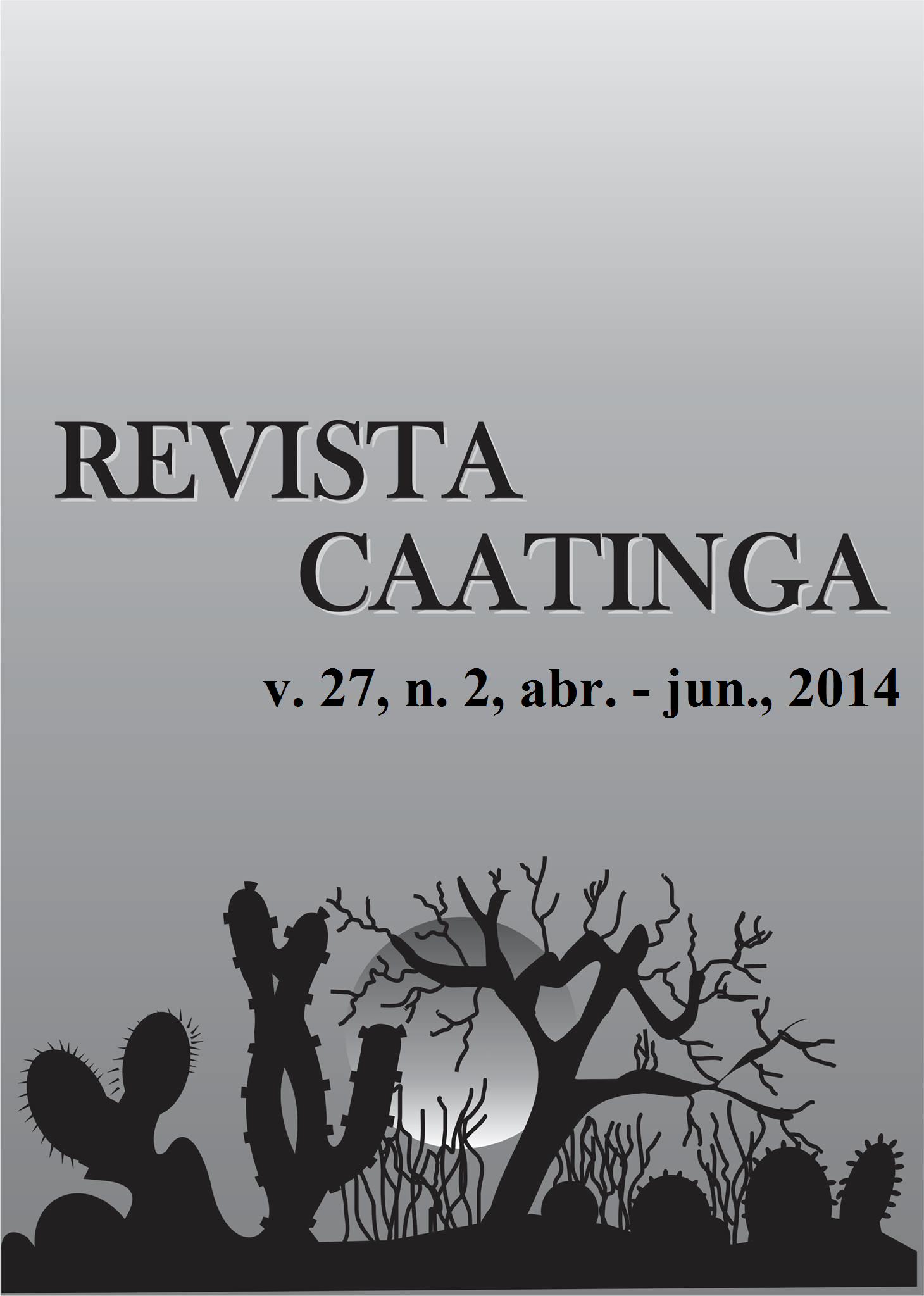RELATIVE TOXICITY OF MUSTARD ESSENTIAL OIL TO INSECT-PESTS OF STORED PRODUCTS
Palavras-chave:
Biofumigation. Callosobruchus maculatus. Grains. Sitophilus zeamais.Resumo
The relative toxicity of the mustard (Brassica rapa L.) essential oil (MEO) on young and old larvae, pupae, and adults of Sitophilus zeamais and Callosobruchus maculatus was determined using concentration-response bioassays. The respiration rate of adults was measured to determine its influence on its toxicity. Different developmental stages of both species differed significantly in their response to MEO, with the adults being much more susceptible than the immature stages. Although adult mortality did not differ between species, the adult respiration rate of C. maculatus was significantly higher than that of S. zeamais. Thus, the toxicity oil for adults was not influenced by natural respiration rate of species investigated.Downloads
Referências
COSTA, J. T. et al. Effects of different formulations of neem oil-based products on control Zabrotes Subfasciatus (Boheman, 1833) (Coleoptera: Bruchidae) on beans. Journal of Stored Products Research, v. 56, n. 1, p. 49-53, 2014.
COTTON, R. T. The relation of respiratory metabolism of insects to their susceptibility to fumigants. Journal of Economic Entomology, v. 25, n. 5, p. 1088-1103, 1932.
DHINGRA, O. D.; COSTA, M. L. N.; SILVA JÚNIOR, G. J. Potential of allyl isothiocyanate to control Rhizoctonia solani seedling damping off and seedling blight in transplant production. Journal of Phytopathology, v. 152, n. 6, p. 352-357, 2004.
FOUAD, H. A. et al. Botanical extracts of plants from the brazilian cerrado for the integrated management of Sitotroga Cerealella (Lepidoptera: Gelechiidae) in stored grain. Journal of Stored Products Research, v. 57, n. 1, p. 06-11, 2014.
GUERRA, A. M. N. M. et al. Atividade inseticida de plantas medicinais sobre Callosobruchus Maculatus (Coleoptera: Bruchidae). Revista Caatinga, Mossoró, v. 22, n. 1, p. 146-150, 2009.
ISIKBER, A. A. et al. Fumigant toxicity of essential oils from Laurus Nobilis and Rosmarinus Officinalis against all life stages of Tribolium Confusum. Phytoparasitica, v. 34, n. 2, p. 167-177, 2006.
ISMAN, M. B. Botanical insecticides: For richer or poorer. Pest Management Science, v. 64, n. 1, p. 8-11, 2008.
MANSOUR, E. E. et al. Effect of allylisothiocyanate on Sitophilus Oryzae, Tribolium Confusum and Plodia Interpunctella: Toxicity and effect on insect mitochondria. Crop Protection, v. 33, n. 1, p. 40-51, 2012.
MARTINAZZO, A. P. et al. Utilização da fosfina em combinação com o dióxido de carbono no controle do Rhyzopertha Dominica (F.). Pesquisa Agropecuária Brasileira, Brasília, v. 35, n. 6, p. 1063-1069, 2000.
MCKENZIE, J. A. Selection against resistant phenotypes. In: MCKENZIE, J. A. (Ed.). Ecological and evolutionary aspects of insecticide resistance. Austin: Academic Press, 1996. 185 p.
PIMENTEL, M. A. G. et al. Phosphine resistance in brazilian populations of Sitophilus Zeamais Motschusky (Coleoptera: Curculionidae). Journal of Stored Products Research, v. 45, n. 1, p. 71-74, 2009.
PIMENTEL, M. A. G. et al. Phosphine resistance, respiration rate and fitness consequences in stored-product insects. Pest Management Science, v. 63, n. 9, p. 876-881, 2007.
POTENZA, M. R. et al. Efeito de produtos naturais irradiados sobre Sitophilus Zeamais Mots. (Coleoptera: Curculionidae). Arquivos do Instituto Biológico, São Paulo, v. 71, n. 4, p. 477-484, 2004.
ROBERTSON, J. L.; PREISLER, H. K. Pesticide bioassays with arthropods. Boca Raton: CRC Press, 1992.
SANTOS, J. C. et al. Fumigant toxicity of allyl isothiocyanate to populations of the red flour beetle Tribolium Castaneum. Journal of Stored Products Research, v. 47, n. 3, p. 238-243, 2011.
SAS Institute. SAS/STAT User`s Guide, version 8. Cary: SAS Institute, 1999, 3863 p.
SILVA, G. N. et al. Bioactivity of Jatropha Curcas L. to insect pests of stored products. Journal of Stored Products Research, v. 48, n. 1, p. 111-113, 2012.
SOUSA, A. H. et al. Developmental and population growth rates of phosphine-resistant and susceptible populations of stored product insect-pests. Journal of Stored Products Research, v. 45, p. 241-246, 2009.
SOUSA, A. H. et al. Ozone as a management alternative against phosphine-resistant insect-pests of stored products. Journal of Stored Products Research, v. 44, n. 4, p. 379-385, 2008.
SOUSA, A. H. et al. Ozone toxicity and walking response of populations of Sitophilus Zeamais (Coleoptera: Curculionidae). Journal of Economic Entomology, v. 105, n. 6, p. 2187-2195, 2012.
TSAO, R.; PETERSON, C. J.; COATS, J. R. Glucosinolate breakdown products as insects fumigants and their effect on carbon dioxide emission of insect. BMC Ecology, v. 2, n. 5, p. 1-7, 2002.
Downloads
Publicado
Edição
Seção
Licença
Os Autores que publicam na Revista Caatinga concordam com os seguintes termos:
a) Os Autores mantêm os direitos autorais e concedem à revista o direito de primeira publicação, com o trabalho simultaneamente licenciado sob a Licença Creative Commons do tipo atribuição CC-BY, para todo o conteúdo do periódico, exceto onde estiver identificado, que permite o compartilhamento do trabalho com reconhecimento da autoria e publicação inicial nesta revista, sem fins comerciais.
b) Os Autores têm autorização para distribuição não-exclusiva da versão do trabalho publicada nesta revista (ex.: publicar em repositório institucional ou como capítulo de livro), com reconhecimento de autoria e publicação inicial nesta revista.
c) Os Autores têm permissão e são estimulados a publicar e distribuir seu trabalho online (ex.: em repositórios institucionais ou na sua página pessoal) a qualquer ponto antes ou durante o processo editorial, já que isso pode gerar alterações produtivas, bem como aumentar o impacto e a citação do trabalho publicado (Veja O Efeito do Acesso Livre).







